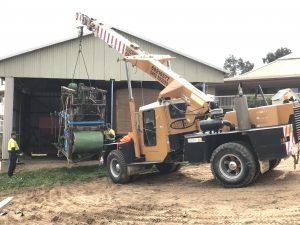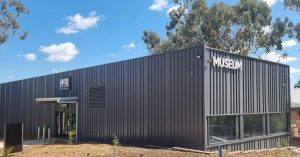
By Leila Davandeh
Library and Museum Assistant
Wagga Wagga City Council
In 2018 the Museum of the Riverina relocated its collection into offsite storage as part of its redevelopment. Museum Assistant, Sophie Magnusson and I were tasked to relocate the Agricultural Machinery Collection, which the Wagga Wagga & District Historical Society (WWDHS) had acquired over the past few decades. This collection holds several significant pieces of agricultural machinery used at the Wagga Experiment Farm and several other large objects donated by members of the Riverina’s farming community.
These objects were stored in a long shed at the Museum of the Riverina backyard, known as the LongShed Collection among the museum staff. Coming from a librarianship background, I couldn’t identify any of them. Their names sounded more like armoured warfare ammunition: The Mitchell Drill, Poison cart, or an Auto header.
My English vocabulary needed to be more robust to comprehend their significance. They were iconic objects, reflecting the agricultural development history of Wagga Wagga.
It was only a few years since we immigrated to Wagga Wagga from Iran, Tehran, with approximately 10 million people. I was used to skyscrapers, huge shopping malls, big crowds, pollution, and traffic jams, and Wagga Wagga, with its generous blue sky, streaming Murrumbidgee river, wide streets, and green paddocks, embraced us. The day we landed on Wiradjuri land, the same breeze stirring gum tree leaves danced among my hair. Here in Australia, I had the choice to take the cover off my hair.
At school, we were taught about the ancient Persian civilization. We were proud of the Persepolis, the ceremonial capital of the Achaemenid Empire (550–330 BC), or Taq Kasra, the remains of a Sasanian-era monument. However, we were allegedly deprived of learning about contemporary social history. We couldn’t recognise a piece of old rusty machinery as a tangible element of a regional life story.
After the 1978 revolution in Iran, the current regime removed 50 years of historical documents (1925-1979) from libraries and archives. It then banned publishing, teaching, even researching it and persecuted those who did so. They rewrote history and narrated it through their perspective, which we as the young generation hated. We knew they were lying, but we couldn’t access the truth either. Our older generation not only had lost their past 50 years of history, they were also too scared to share it with the next generation.
When my supervisor handed me the significance report of the LongShed collection, my ignorance about Riverina – which has been the leading regional producer of wheat in Australia since the early part of the 20th century – became more apparent. I immersed myself in the documents, photographs, books, brochures, and oral history files available on the objects. I found out how all these documents have been stored, preserved, and donated to the museums, libraries, and archives by locals enthusiastic about their history. They were sitting in boxes, drawers, and shelves, waiting to be retrieved and researched. Authorities did not hide them or deprive members of their communities just because they disagreed with how the past governments ruled the country.
I was amazed by the extensive knowledge of my female colleagues about farming, as agriculture was always defined as a masculine job. They had postgraduate degrees in Art and history and still knew all the details on agriculture, horticulture, and animal farming. They were leading busy lives. They raised families, worked full-time as museum curators, and ran their farms alongside their partners. They would come to work in their muddy boots because they chased their newborn lambs on their farms, trying to bottle feed them. In Iran, I was a librarian at a university library, the mother of a 13-year-old boy, and in charge of a couple of indoor plants. Still, most of the time, I was overwhelmed by the responsibilities. Their level of resilience always surprised me.
My terminology in farming and agriculture was growing vastly. I learned a lot about the history of agriculture and farming in the region through the “Agricultural Machinery Collection.”
By now, I had learned that the Rabbit Poison Cart was designed to lay poison to combat the rabbit plague in Australia. In the early 1900s, the Tokley family, headed by Ada and George Tokley purchased it and used it on their 320 acres farm, Avondale Park, outside Coolamon to put out the phosphorous baits and went around each morning in the sulky to pick up a load of rabbits. It was only 20 kilometres away from where we were living.
We interviewed a drover’s son whose dad’s droving cart was one of the Long Shed Collection objects. Don McKenzie had been a drover since he was a very young man. He sometimes drove 1700 sheep to Ivanhoe, Wilcannia, and Hillston, three trips a year for a 100 dollar a day. The cart was his home when moving stock from one place to another. With Don on the road up to seven months, his wife Coral stayed in Wagga Wagga, working full time and raising their five children.
The three-meter tall homemade mechanical almond cracking machine, Almond Sheller, was the only homemade machine of its type in the world. It was invented at Wagga Experiment Farm (later Wagga Agricultural College). The Wagga Experiment Farm was established in 1892 to meet agricultural research and education in the Riverina region. The engineers and students working and studying there would make their own devices based on their needs. They didn’t need to wait weeks or months for the spare parts from the other side of the world. Their bright minds and creativity would be their tools to repair pieces of machinery on the farm. It shows the make-do-and-mend approach of the past generation, which is very different from our current practice of discarding and replacing.
To relocate the collection to offsite storage, we hired the local crane crew. By then, I understood the collection’s value so well that I couldn’t help approaching the crane operators while wearing high vis and helmet and reminding them of their task’s delicacy in my Iranian accent.
I was in the middle of the LongShed Collection project when my dad passed away from a long battle with Alzheimer’s disease. I flew back home to attend the funeral. However, my passport was confiscated at Tehran airport on my arrival, and I was referred to the national security police department. It took me six months to convince the Iranian authorities that due to my past women’s rights activities in Iran, I was not a risk to the country’s national security. As soon as I returned ‘home’ to Wagga Wagga, I restarted work on the LongShed Collection. The Two-wheeled dray was one of the most significant objects in the collection belonging to Mary Ryan. It was donated to the museum by Jack Ryan, Mary’s grandson, in the 1960s.
She emigrated from Ireland with her family in 1865 and lost her husband, Daniel, at sea during the journey. Mary and her children, three daughters and four sons, settled in the Riverina region. In the late 19th century, Mary overcame the trauma of leaving her motherland and losing her partner by making a new life in another country. In the early 21st century, I decided to survive mine and resume.
The LongShed Collection storyline will carry on. It paralleled with mine, a 42-year old Iranian librarian, as it has already aligned with the lives of many others.




